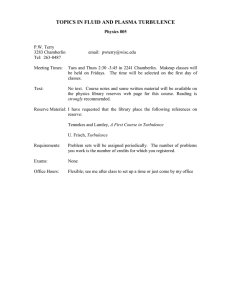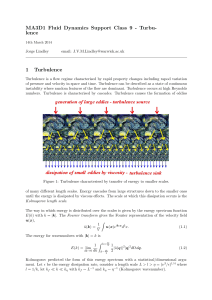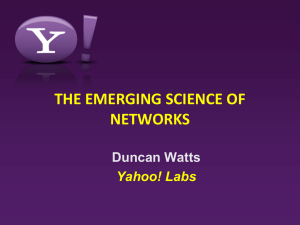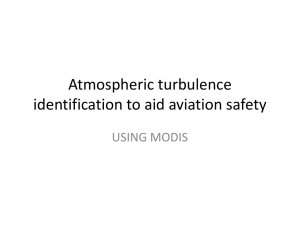NONLINEAR SCALE-FREE CASCADES AND THEIR STATIONARY SPECTRA
advertisement
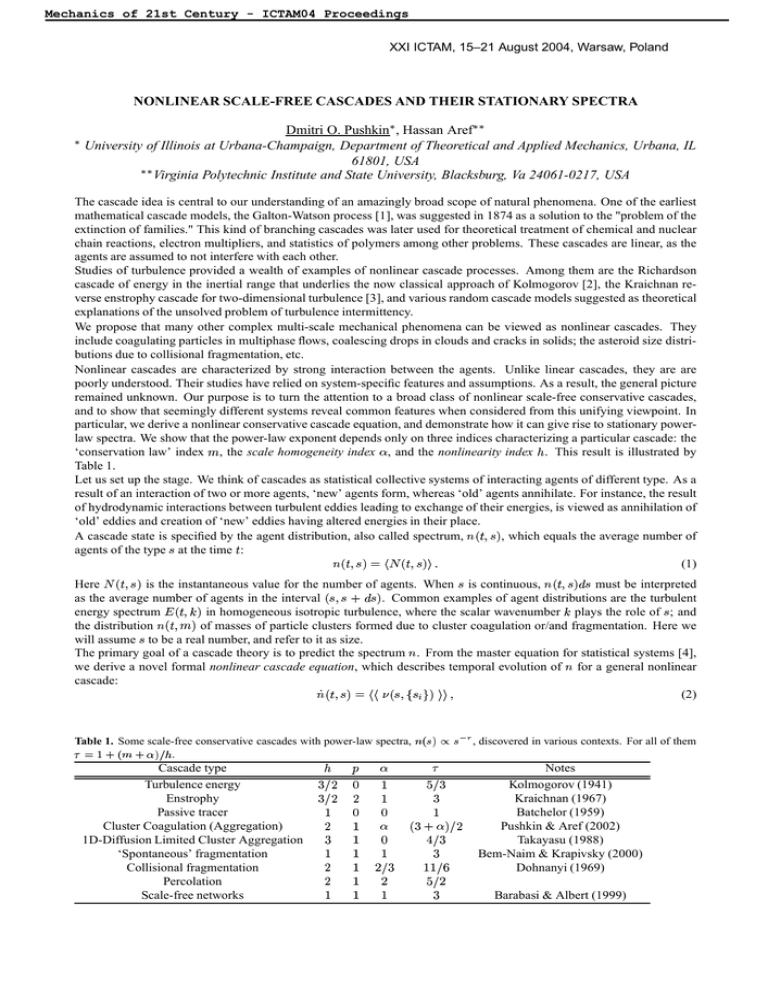
Mechanics of 21st Century - ICTAM04 Proceedings XXI ICTAM, 15–21 August 2004, Warsaw, Poland NONLINEAR SCALE-FREE CASCADES AND THEIR STATIONARY SPECTRA Dmitri O. Pushkin , Hassan Aref University of Illinois at Urbana-Champaign, Department of Theoretical and Applied Mechanics, Urbana, IL 61801, USA Virginia Polytechnic Institute and State University, Blacksburg, Va 24061-0217, USA The cascade idea is central to our understanding of an amazingly broad scope of natural phenomena. One of the earliest mathematical cascade models, the Galton-Watson process [1], was suggested in 1874 as a solution to the "problem of the extinction of families." This kind of branching cascades was later used for theoretical treatment of chemical and nuclear chain reactions, electron multipliers, and statistics of polymers among other problems. These cascades are linear, as the agents are assumed to not interfere with each other. Studies of turbulence provided a wealth of examples of nonlinear cascade processes. Among them are the Richardson cascade of energy in the inertial range that underlies the now classical approach of Kolmogorov [2], the Kraichnan reverse enstrophy cascade for two-dimensional turbulence [3], and various random cascade models suggested as theoretical explanations of the unsolved problem of turbulence intermittency. We propose that many other complex multi-scale mechanical phenomena can be viewed as nonlinear cascades. They include coagulating particles in multiphase flows, coalescing drops in clouds and cracks in solids; the asteroid size distributions due to collisional fragmentation, etc. Nonlinear cascades are characterized by strong interaction between the agents. Unlike linear cascades, they are are poorly understood. Their studies have relied on system-specific features and assumptions. As a result, the general picture remained unknown. Our purpose is to turn the attention to a broad class of nonlinear scale-free conservative cascades, and to show that seemingly different systems reveal common features when considered from this unifying viewpoint. In particular, we derive a nonlinear conservative cascade equation, and demonstrate how it can give rise to stationary powerlaw spectra. We show that the power-law exponent depends only on three indices characterizing a particular cascade: the ‘conservation law’ index , the scale homogeneity index , and the nonlinearity index . This result is illustrated by Table 1. Let us set up the stage. We think of cascades as statistical collective systems of interacting agents of different type. As a result of an interaction of two or more agents, ‘new’ agents form, whereas ‘old’ agents annihilate. For instance, the result of hydrodynamic interactions between turbulent eddies leading to exchange of their energies, is viewed as annihilation of ‘old’ eddies and creation of ‘new’ eddies having altered energies in their place. A cascade state is specified by the agent distribution, also called spectrum, , which equals the average number of agents of the type at the time : (1) Here is the instantaneous value for the number of agents. When is continuous, must be interpreted as the average number of agents in the interval . Common examples of agent distributions are the turbulent energy spectrum in homogeneous isotropic turbulence, where the scalar wavenumber plays the role of ; and the distribution of masses of particle clusters formed due to cluster coagulation or/and fragmentation. Here we will assume to be a real number, and refer to it as size. The primary goal of a cascade theory is to predict the spectrum . From the master equation for statistical systems [4], we derive a novel formal nonlinear cascade equation, which describes temporal evolution of for a general nonlinear cascade: (2) Table 1. Some scale-free conservative cascades with power-law spectra, !" " $ # %& . Cascade type Turbulence energy Enstrophy Passive tracer Cluster Coagulation (Aggregation) 1D-Diffusion Limited Cluster Aggregation ‘Spontaneous’ fragmentation Collisional fragmentation Percolation Scale-free networks ' )*+ , , ( - . *) ) )*+ + - - , , - + - ) *+ ) - , / *) - - - ) + - + *) - -*0 + - + .*+ - - - ) discovered in various contexts. For all of them Notes Kolmogorov (1941) Kraichnan (1967) Batchelor (1959) Pushkin & Aref (2002) Takayasu (1988) Bem-Naim & Krapivsky (2000) Dohnanyi (1969) Barabasi & Albert (1999) Mechanics of 21st Century - ICTAM04 Proceedings where the following notation has been introduced: for any function Here , (3) is the number of agents of size created due to an "elementary" interaction of agents of sizes ; is the probability of this interaction per unit time, the square brackets emphasize dependence on the whole distribution . The summation in (3) is carried over all sets . As an example, we show that both the turbulent energy transfer equation [5] and the Smoluchowski coagulation equation [6] can be written in this form. At this point equation (2) is not closed, as the interaction strength depends on microdistribution . However, for a wide class of conservative scale-free cascades the asymptotic spectra can be found without solving the closure problem. The condition that a processes is scale free has several consequences: first, interactions have no characteristic size. In mathematical terms: if , then (4) For instance, for homogeneous isotropic turbulence - and this value can be traced to the gradient operator in the Navier-Stokes equations. For coagulation, is the homogeneity degree of the coagulation kernel. Next, the interactions must be scalable in agent density. Thus, if , (5) For example, for homogeneous isotropic turbulence ) * + , because the interactions depend on the third order velocity correlation function, and velocity scales as square root of energy. For coagulation + due to binary collisions. Let the conservation law read: (6) , for any set . For instance, the energy conservation law for turbulence yields , , while enstrophy conservation for 2D turbulence results in + . Mass conservation in coagulation and fragmentation cascades yields -. A cascade can be maintained in a stationary state by constant ‘forcing’ through an influx of the conserved quantity at some scale . Then, we demonstrate that steady spectrum has the form: * ( - (7) We show that for wide classes of interactions the system completely "forgets" the small scale at much larger . This is referred to as similarity of the first kind or complete similarity [7]. Then, and, thus, (8) Such interaction classes depend on asymptotic properties of the interactions. They have been determined for cluster coagulation [8] and the weak wave approximation in turbulence (‘locality conditions’) [9]. The constant was first introduced by Kolmogorov [2], and is often denoted as . It is clearly interaction-dependent and, therefore, non-universal. For cluster coagulation an expression for was found in [8]. The important relation (8) is our central result. It includes as particular cases the Kolmogorov spectrum, the Kraichnan spectrum for two-dimensional turbulence, the Batchelor spectrum for a passive tracer, and other cascades, including some fractal models of intermittency. Table 1 confirms that (7) has, in fact, much broader applicability. It can also serve as a powerful tool for analyzing new power-law spectra generated by cascade processes, due to the clear physical meaning of the indices , , and . References [1] Watson, H. W., Galton F. On the probability of the extinction of families. J. Antropol Inst. Great Britain and Ireland 4: 138, 1874. [2] Kolmogorov, A. N. The local structure of turbulence in incompressible viscous fluid for very large Reynolds numbers. Dokl. Acad. Nauk SSSR 31:538, 1941. [3] Kraichnan, R. H. Inertial ranges in two-dimensional turbulence. Phys. Fluids 10 (7):1417, 1967. [4] van Kampen, N. G. Stochastic processes in Physics and Chemistry, North-Holland, Amstredam, 1981. [5] Frisch, U. Turbulence. Cambridge University Press, Cambridge, 1995. [6] Smoluchowski v. M., Drei Vorträge über Diffusion, Brownische Bewegung und Koagulation von Kolloidteilchen. Phys. Z. 17: 557, 1916 [7] Barenblatt, G. I.: Scaling, self-similarity and intermediate asymptotics. Cambridge University Press, Cambridge, 1996. [8] Pushkin, D. O., Aref, H.: Self-similarity theory of stationary coagulation. Phys. Fluids 14 (2):694, 2002. [9] Zakharov, V. E., L’vov, V. S., Falkovich G. E. Kolmogorov spectra of turbulence. Springer-Verlag, 1992. << session << start

